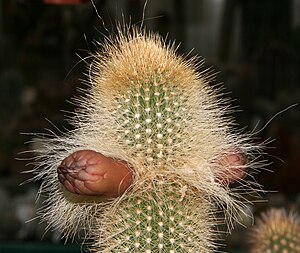Pilosocereus chrysostele
| Pilosocereus chrysostele | ||||||||||||
|---|---|---|---|---|---|---|---|---|---|---|---|---|

Pilosocereus chrysostele |
||||||||||||
| Systematics | ||||||||||||
|
||||||||||||
| Scientific name | ||||||||||||
| Pilosocereus chrysostele | ||||||||||||
| ( Vaupel ) Byles & GDRowley |
Pilosocereus chrysostele is a species of plant in the genus Pilosocereus from the cactus family(Cactaceae). The specific epithet chrysostele means 'gold pillar'.
description
Pilosocereus chrysostele grows shrubby, branches only at the base and reaches heights of 1.5 to 3 meters. The upright, smooth shoots are light green and 4 to 7 centimeters in diameter. There are 22 to 23 ribs. The translucent thorns are light yellow. The ascending 6 to 8 central spines are 0.4 to 1.2 inches long. The 9 to 12 outspread radial spines are 4 to 10 millimeters long. The flowering part of the shoots is very distinct. White hairs up to 2 centimeters in length and gold-colored, 4 to 6 centimeters long bristles arise from the lateral areoles and those near the tip of the shoot.
The short and broad tubular to funnel-shaped, white flowers are more or less pink or brownish on the outside. They are 4.5 to 5 centimeters long and 3.5 centimeters in diameter. The depressed spherical fruits reach a diameter of 3 to 3.5 centimeters, tear laterally or near their base and contain a magenta colored pulp.
Distribution, systematics and endangerment
Pilosocereus chrysostele is widespread in northeastern Brazil at altitudes of 430 to 600 meters.
There are two subspecies:
- Pilosocereus chrysostele ssp. chrysostele , occurrence: Pernambuco, Paraiba, Rio Grande do Norte
- Pilosocereus chrysostele ssp. cearensis P.J.Braun & Esteves (Ceará)
The first description as Cereus chrysostele was published in 1923 by Friedrich Karl Johann Vaupel (1876–1927). Ronald Stewart Byles and Gordon Douglas Rowley placed them in the genus Pilosocereus in 1957 . A synonym is Pseudopilocereus chrysostele (Vaupel) Buxb.
The subspecies Pilosocereus chrysostele ssp described by Pierre J. Braun and Eddie Esteves in 1999 . cearensis P. J. Braun & Esteves has now been confirmed as endemic to Ceará. This subspecies differs very easily in the absence of the pseudocephalium.
In the Red List of Threatened Species of IUCN is the species as " Near Threatened (NT)", d. H. listed as low risk.
proof
literature
- Edward F. Anderson : The Great Cactus Lexicon . Eugen Ulmer KG, Stuttgart 2005, ISBN 3-8001-4573-1 , p. 538 .
Individual evidence
- ^ Journal of Succulents . Berlin 1923, p. 58.
- ^ Cactus and Succulent Journal of Great Britain . Volume 19, No. 3, London 1957, p. 66.
- ↑ British Cactus & Succulent Journal Vol. 17, No. 1 (March 1999), pp. 21-27
- ^ MO Teles de Menezes, NP Taylor, I. Bezerra Loiolal: Flora do Ceará, Brazil: Cactaceae, Rodriguésia vol.64 no.4 Rio de Janeiro Oct./DEC. (2013)
- ↑ Pilosocereus chrysostele in the Red List of Threatened Species of the IUCN 2013.2. Posted by: Zappi, D., Machado, M. & Taylor, NP, 2010. Retrieved January 3, 2014.

